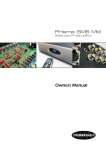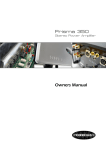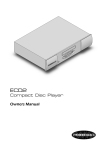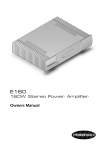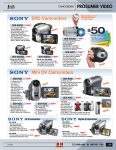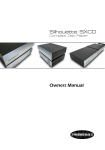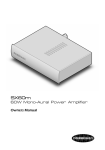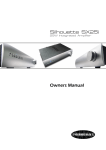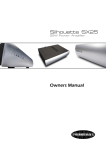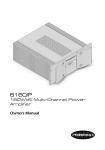Download Perreaux CD Player CD Player User Manual
Transcript
Prisma CD1 Compact Disc Player Owners Manual Perreaux Industries Limited makes no warranty for the use of its products, other than those expressly contained in the warranty detailed herein. The Company assumes no responsibility for any errors which may appear in this document, reserves the right to change products or specifications detailed herein at any time without notice, and does not make any commitment to update the information contained herein. No licenses to patents or other intellectual property of Perreaux are granted by the Company in connection with the sale of Perreaux products, expressly or by implication. mboob^ru® is a registered trademark of Perreaux Industries Ltd. Terms and product names in this document may be trademarks of others. 2 i Introducing the Perreaux CD1 Compact Disc Player Congratulations on your Perreaux CD1 purchase. To realise the full potential of your unit you need to appreciate all aspects of its operation. Before installing the CD1 into your system, read the entire manual carefully. Endeavour to understand every detail by familiarising yourself with the controls and features as you read. You will find it easier to install using the relevant sections of this manual as a reference. We have attempted to explain every feature and operational facet clearly and concisely. In the event that something is still unclear to you, your Perreaux dealer will be happy to assist you further. Read this manual, install your unit correctly and realise the sonic significance of your investment in Perreaux. Perreaux products are designed to provide the utmost in sonic realism and electronic reliability with a functional yet elegant appearance that reflects the care and craftsmanship applied during all stages of construction. Features at a Glance Rugged build quality M ultiple regulated power supplies Burr Brown DAC High speed processing with 96kHz over-sampling Balanced analog outputs Digital output Full function infrared remote control To maintain the consistently high quality that you expect from us, and we expect from ourselves, Perreaux products are handcrafted. We maintain the human-link throughout, from design and construction, through to the ultimate test, your music, your system, your ears. Because we too listen to our products, we know that with your Perreaux you will discover many more of the musical secrets we strive to reveal. From all of us at Perreaux Industries Limited, thank you for choosing the Perreaux CD1 compact disc player. 3 ii Important Safety Instructions Note: All safety and operation instructions should be read carefully before the CD1 is operated. Keep the Owners Manual in a safe place for future reference. The CD1 should not be used near water, for example near a bathtub, kitchen sink, in a wet basement, near a swimming pool, etc. The CD1 should be rack mounted only in a heavy-duty rack or stand that is recommended for audio equipment use. M ounting to a wall or ceiling should be via a heavy-duty bracket or shelf designed for audio equipment use. The CD1 should be situated away from heat sources such as radiators, stoves, or other appliances that produce excessive amounts of heat. DO NOT place the CD1 directly onto carpeted surfaces. Avoid exposing the CD1 to extremely high or low temperatures. The CD1 should be connected to a mains power supply only of the type described in the operating instructions, or as marked on the rear of the unit. DO NOT disconnect the mains earth from the system. The mains power supply cord should be routed so that it is not likely to be walked on or pinched by items placed on or against it. The power cord of the CD1 should be unplugged from the mains outlet when the unit is to be left unused for long periods or when attempting to connect or disconnect cables and before cleaning your unit. Care should be taken so that objects and/or liquids do not accidentally fall inside the CD1. Please keep electrical equipment out of reach of children. Please unplug sensitive electronic equipment during electrical storms. Please replace any fuse with the value and type specified. Avoid operating the CD1 with the cover removed. DO NOT bypass any fuse. DO NOT attempt to repair the CD1. In the event of a problem, please contact your Perreaux dealer. 4 iii Table of Contents i ii iii 1 2 3 4 5 6 7 8 9 10 11 12 13 14 15 Introducing the Perreaux CD1 Compact Disc Player ...............................................3 Important Safety Instructions ........................................................................................4 Table of Contents ..............................................................................................................5 Unpacking and Placement..............................................................................................6 Instant Install......................................................................................................................7 Front Panel Functions......................................................................................................8 Rear Panel Functions..................................................................................................... 10 Remote Control Functions........................................................................................... 13 Special Design Philosophies ........................................................................................ 16 Special Design Features................................................................................................ 18 Maximising System Potential ...................................................................................... 19 Care and Maintainance ................................................................................................ 20 Warranty Information and Obtaining Service........................................................ 21 Extended Warranty Registration Form .................................................................... 22 Faultfinding Your System ............................................................................................. 23 Specifications................................................................................................................... 28 Physical Dimensions ...................................................................................................... 31 Contact Details................................................................................................................ 32 5 1 Unpacking and Placement The CD1 is packaged for maximum protection. Please carefully read the instructions below before proceeding to unpack the unit. Be extremely careful. Unpacking Procedure Note: Inspect both ends of the cardboard box and open at the end without the central staple by slitting the reinforced tape at either side. Fold back the flaps and tip the package on end and the inner box will slide out. Lay the inner box down flat and upright, open it conventionally by separating the top tray from the bottom. The product can now be removed from the bottom packaging. This will be easier if you have someone to help you by holding the base of the box. Alternately, the bottom tray and player could be tipped upside down and the bottom packaging removed. If opened in this manner, please ensure that you turn the contents over again. Be very careful to secure the unit if you are planning to flip the package upside down. Remove the two white polystyrene protectors off either side of the player, leaving the black material covering. Pull back the material and remove the protective black tissue from the front panel. The player is now unpacked and ready for further installation. Note: Please retain all packaging material for future transport. Box Contents 1 x CD1 Compact disc player 1 x CD1 Product manual 1 x Perreaux remote control 2 x AAA batteries 1 x Screwdriver 1 x Detachable AC power cord Placing Your CD1 The CD1 should generally be placed close to your amplifier, keeping the interconnect cabling short. 6 2 Instant Install If you are like us, the first thing you will want to do is to play your favourite piece of music through your new CD1. The following instructions are written to enable you to achieve this as quickly as possible. These are not comprehensive instructions, but are designed to enable you to play music now! Note: Please take the time to read the CD1 manual thoroughly as it incorporates many features, which will enhance its operation. Placement Best results will be achieved when placed on a solid surface. DO NOT place on a carpeted floor or cover the player! Turn off associated components This minimises the potential to damage any other components when connecting your CD1 into the system. Connect CD1 to amplifier Connect the output of the CD1 to the unbalanced (RCA) inputs at the rear of your amplifier. Note: Try to keep all interconnect cables as far from loudspeaker cabl es as possible and well away from all AC mains leads. Switch on CD1 After checking the supply voltage compatibility with the voltage rating on the CD1 rear panel, insert the power cord-set supplied into the rear of the unit and into the wall. Switch on the socket at the wall and power up the CD1 by setting the switch on the rear panel to ON ( I ). Switch on your amplifier M ake sure your amplifier is connected to the mains and switch it on. Insert your favourite CD Open the disc drawer by pressing the ‘O/C’ button and insert your favourite CD. Press ‘PLAY’ on the CD1 Increase the volume Slowly increase the volume control of your amplifier to achieve a comfortable listening level. CONGRATULATIONS! Now that you have achieved your first objective, sit back, relax and please read the rest of the manual at your own pace, in your favourite armchair, whilst sipping a hot cup of coffee. You’ll find the whole experience much more pleasurable whilst listening to music. 7 3 Front Panel Functions Vacuum Fluorescent Display Display provides information regarding the status of the CD1 and track/time information for the disc being played. ‘RPT’ Button Allows you to repeat the current track or the entire disc continuously until the feature is cancelled by pressing the RPT button or pressing ‘■’. The RPT button steps sequentially through the available options. Pressing the button once repeats the current track, displaying REPEAT 1 in the display. Pressing a second time repeats the entire disc, displaying REAPEAT ALL in the display. Press a third time to cancel the REPEAT function. Note: The REPEAT function is automatically cancelled when the disc drawer is opened. ‘O/C’ Button When the disc drawer is closed, pressing this button opens the drawer. To close the drawer, press the button again. Pressing ‘►’ or lightly pushing on the drawer itself can also close the drawer. This can also be performed via the remote control. When the drawer is open, the display reads ‘OPEN’. When it is closed with no disc, the display reads ‘NO DISC’. When the drawer closes with a disc inserted, the display will show the number of tracks and the total time of the disc. ‘►’ Button Press this button to start playing the disc. If the disc drawer is open, it will close automatically. The number of the track being played and the and the elapsed time will be shown in the display, along with the PLAY indicator. 8 ‘ ■’ Button This button stops a disc that is playing and resets the player, i.e. if play is resumed, the disc will start over from the first track. ‘ ’ Button Pressing this button returns to the beginning of the current track. Pressing twice quickly in succession returns to the beginning of the previous track. The new track number is shown in the display. ‘ ’ Button Pressing this button advances to the beginning of the next track. The new track number is shown in the display. ‘STBY’ Button This button puts the CD1 into STANDBY mode, as indicated by the red standby light. The display goes dark and the unit will not operate. HDCD Indicator This light will illuminate to indicate that an HDCD encoded disc is being played. IR Sensor This is the infrared sensor to receive commands transmitted from the remote control. 9 4 Rear Panel Functions Caution! Please make all changes at minimum volume setting. Only increase the volume after the connections have been made. Digital Output Using a standard 75Ω coax digital cable with RCA termination, connect the digital output to the coax digital input on the external D/A converter. These high quality gold plated sockets are highly conductive, corrosion resistant, and provide less potential for corrosion induced distortion. Refer to Chapter 13 “Specifications” for more details. Unbalanced Analog Output Standard single-ended outputs (RCA) supplying analog signals to the source inputs of an audio preamplifier, integrated amplifier or receiver. Using quality audio interconnect cables, connect the left channel output of the CD1 to the left channel input on the preamplifier or other component and the right channel output to the right channel input on the preamplifier or other component. Refer to Chapter 13 “Specifications” for more details. Balanced Analog Output Balanced outputs (XLR) providing analog signals to drive a preamplifier, integrated amplifier or receiver equipped with a balanced input. Connection should be made with high quality cables fitted with XLR connectors. Connect the left channel output of the CD1 to the left channel input on the preamplifier or other component and the right channel output to the right channel input on the preamplifier or other component. 10 The pin assignments of the balanced XLR output connectors are as follows: Pin 1: Signal ground Pin 2: Signal + (non-inverting) Pin 3: Signal – (inverting) Shield ground: Chassis ground Caution! Please refer to the operating manual of your preamplifier; integrated amplifier or receiver to verify that the pin assignments of the input connectors correspond to the CD1 balanced outputs. In the event that they are not compatible, the interconnecting cable will need to be altered to suit. Serial Number The serial number is unique to your CD1. Please record this number and store it in a safe place. For any service related enquiry, please be prepared to quote the product serial number to Perreaux personnel or their service representative. Input Voltage and Fuse Rating Input Voltage It is important that the CD1 be operated from the correct AC mains voltage. This unit is factory set for the voltage applicable to the original country of destination. The CD1 will operate satisfactorily within a voltage variation of up to ±5% of that voltage at which the unit has been set. If you require the voltage setting to be altered, e.g. relocation to another area, city or country, or extraordinarily high or low voltages, please contact your Perreaux dealer. Qualified service personnel can only perform this modification. Caution! Never attempt to connect the unit to the incorrect voltage. damage can result from applying incorrect voltage to the unit. Severe Fuse Rating The fuse rating displayed here, refers to the rating of the mains inlet fuse. For more information on fuse ratings, please refer to Chapter 13 “Specifications”. Caution! Never replace the fuses with any other ratings other than the one specified. 11 AC Mains Input and Fuse AC Mains Input An IEC-standard mains input is provided at the rear of the unit. The AC cord set is removable, allowing you to upgrade to a cord set of your preference. Caution! Prior to connection to the AC mains, please check the voltage label on the rear panel to ensure that your unit conforms to the power supply in your area. Never attempt to connect the unit to the incorrect voltage. Severe damage can result from applying incorrect voltage to the unit. Mains Fuse The CD1 is equipped with a user serviceable AC mains fuse. In the event of fuse failure, always replace with the same type and value fuse. Remember, fuses do not usually blow without a reason. Any doubts about fuse failure should be conveyed directly to your Perreaux dealer. For more information on fuse ratings, please refer to Chapter 13 “Specifications”. Caution! This is the ONLY user accessible fuse. Never replace the fuses with any other ratings other than the one specified on the rear panel. Always ensure your CD1 is disconnected from the mains supply before attempting to change the mains fuse. Power Switch Depress this switch to the right (I) to turn power ON. Depress this switch to the left (O) to turn the CD1 off at which time the outputs will be disconnected. 12 5 Remote Control Functions The CD1 comes supplied with a 36 button Perreaux Universal infrared remote control. The remote control uses 2 x AAA batteries and may be changed by removing the black perspex insert. Note: Press the button on the remote to select the code-set required to control the CD1. The CD1 uses the following functions: Open/Close When the disc drawer is closed, pressing this button opens the drawer. To close the drawer, press the button again. When the drawer is open, the display reads ‘OPEN’. When it is closed with no disc, the display reads ‘NO DISC’. When the drawer closes with a disc inserted, the display will show the number of tracks and the total time of the disc. Program Pressing this button allows you to memorise as many as 20 tracks on the current disc for playback in a specific order. For example, you could instruct the CD1 to play track 6, followed by track 10, followed by track 2. To begin a program: Note: Insert a disc and close the drawer. The CD1 will read the contents of the disc. Press the PROG button on the remote control. The PROGRAM indicator will show on the display, along with ‘P:00’ indicating that the unit is waiting for the first track to be memorised. Enter the first track number using the DIRECT ACCESS buttons. Your selection will be memorised automatically and the display will change to ‘P:01’, indicating that one track has been memorised. Continue entering the rest of your selections using the DIRECT ACCESS buttons. There is no need to press the PROG button, as each selection is memorised as it is entered. Once you have memorised a play list, the CD1 remains in PROGRAM mode until the disc drawer is opened or the STOP button is pressed twice in succession. If you press the PLAY button, the memorised program will play instead of the entire disc, starting with the first selection in the memorised list. 13 Direct Access These numeric buttons are used to directly access a track from the remote control instead of stepping through using the TRACK buttons. The first ten tracks on a disc can be selected by pressing the corresponding button on the remote control. For example, to play the eighth track, press . When accessing track numbers greater than 10, press followed by the track number. For example, to select track 15, press followed by and . The number of the selected track will appear on the display. There is also a four by four matrix of track numbers (1 – 16) at the right side of the display. This indicates all of the tracks on the disc. If there are more than 16, all of the digits will illuminate, accompanied by the word OVER, regardless of which track is playing. This matrix is independent of the main numeric area of the display, which will always indicate the currently playing track, even if above 16. The DIRECT ACCESS buttons may also be used to memorise tracks in PROGRAM mode. Track Forward / Track Backward These buttons are used to select tracks on the disc. When a disc is playing, pressing the TRACK forward button advances to the beginning of the next track. Pressing the TRACK backward button returns to the beginning of the current track. Pressing twice quickly in succession returns to the beginning of the previous track. When pressed and held, these buttons search forward or backward through the currently playing disc. Play Press the PLAY button to start playing the disc. If the disc drawer is open, it will close automatically. The number of the track being played and the elapsed time will be shown in the display, along with the PLAY indicator. Normally, the disc will start playing with the first track. However, you can select a different track using the TRACK buttons or the DIRECT ACCESS buttons before pressing PLAY to start playing a different selection. Pause This button is used to temporarily suspend play. The disc continues to spin and play will be resumed from the current position. The PAUSE indicator will show in the display. To resume playing the disc, press the PAUSE button again or press the PLAY button. Stop This button stops a disc that is playing and resets the player, i.e. if play is resumed, the disc will start over from the first track. Pressing the STOP button twice in quick succession cancels any programmed selections. 14 Random This instructs the CD1 to play tracks from the entire disc in random order. Once all of the selections have been played once, the disc will stop playing, unless the REPEAT function is utilised, in which case the random play will continue until the STOP button is pressed. When the RANDOM feature is in use, the word RANDOM is shown in the display. Repeat This button allows you to repeat the current track or the entire disc continuously until the feature is cancelled by pressing the REPEAT button again or pressing STOP. The REPEAT button steps sequentially through the available options, as indicated: REPEAT 1 REPEAT ALL CANCEL Press the button once and the CD1 will repeat just the current track, displaying the indicators REPEAT 1 in the display. Press the button a second time and the CD1 will repeat the entire disc, displaying REPEAT ALL in the display. Press the button a third time to cancel the REPEAT function. As noted above, REPEAT can be used in conjunction with the RANDOM play feature. Note: The REPEAT function is automatically cancelled when the disc drawer is opened. Time By default, the CD1 displays the elapsed time of the currently playing track. The TIM E button allows you to step through two alternative time display modes: TIM E REM AIN (TRACK) TIM E REM AIN (DISC) TIM E ELAPSED Pressing the button once displays the time remaining in the current track, which counts down as the track continues playing. Pressing the button a second time displays the time remaining on the entire disc (or memorised program). Pressing the button a third time reverts to the standard time elapsed display mode. When the TIM E feature is activated, the word REM AIN appears in the display. 15 6 Special Design Philosophies Perreaux has been designing and manufacturing only the highest quality audio componentry for more than a quarter of a century. Technology has continued to evolve rapidly over that time and our knowledge and application of design, materials and manufacturing techniques has advanced in tandem with this. Today’s Perreaux range comes closer to fulfilling our shared vision than at any other time in the past. To follow is a discussion on some of Perreaux design philosophies that have been incorporated into the entire range. Minimalist Design Leading British architect, John Pawson, writes: “The Minimum can be defined as the perfection that an object achieves when it is no longer possible to improve it by subtraction. This is the quality that an object has when every component, every detail, and every junction has been reduced or condensed to the essentials. It is the result of the omission of the inessentials”. Perreaux has historically embraced the minimalist ethic from an audio design perspective only. The concept of “less equating to more” has been at the heart of all Perreaux audio designs for more than a quarter of a century. Minimalist Electronics We wish to maximise the quality of your listening pleasure by keeping the componentry and signal path as uncluttered, short and clean possible. All components in the signal path, even those of the highest quality have an effect on the signal, thereby altering the quality of the reproduction in some way. Our aim is to recreate in its entirety, the original performance by not adding or subtracting anything, irrespective of the source. Minimalist User Interface We carefully study the user interface and par down the number of buttons and associated clutter leaving just the essential and no more. How tempting it has been over the years to loose sight of our core values as technology or trends have made it possible. That is one of the reasons why our older products still have such a high resale value today. The user interface has and always will remain simple, free from adornments, clean and uncluttered. Minimalist Aesthetics Our products appeal to those who seek the ultimate in audio exclusivity, namely the perfect blend of “form and function”. 16 “Form and function” are both tough masters. That is why our amplifier heat sinks are not hidden, but instead feature prominently in all our designs. We make no excuses for producing some of the most distinctive high-end audio products on the planet. We let “form and function” blend together in perfect harmony. This surely is the essence of true minimalist utilisation. Minimalism in a Wider Context John Pawson writes: “Clearly simplicity has dimensions to it that go beyond the purely aesthetic: it can be seen as the reflection of some innate, inner quality, or the pursuit of philosophical or literary insight into the nature of harmony, reason, and truth”. 17 7 Special Design Features Rugged Build Quality M echanical strength has been a hallmark of Perreaux products since the company first started production back in 1974. The concept behind the physical design and construction is that each structural member should contribute to both rigidity and performance. Multiple Regulated Power Supplies There is a separate regulated power supply for each section of the CD player. One positive supply and one negative supply for the sensitive analog output stage, another one for the DAC section, another for the clock generation of the DAC section and a further supply for the microcontroller and display. The advantage of this is that there is complete isolation from stage to stage, ensuring the analog section is completely free from digital noise. Burr Brown DAC The CD1’s precision transport is backed up by a Burr Brown (Texas Instruments) digital to analog converter. M ulti-level Delta-Sigma operation with 8x over-sampling ensures the CD1 will deliver a high level of audio performance. Balanced Analog Output The CD1 offers a balanced analog output, providing improved noise rejection and cancellation. 18 8 Interconnects and Speaker Cables Maximising System Potential An often-ignored area in high fidelity systems is the cabling connecting the various components. Interconnect leads should be high quality cable with substantial terminations. Gold plate is inherently resistant to corrosion, and an excellent conductor. The presence of corrosion induces distortion and poor conductivity will seriously interfere with sound quality. Terminations must plug snugly into sockets to maintain maximum conductivity and to avoid annoying earthing problems. Speaker cabling is equally critical. Use only solidly constructed cable of high purity copper or silver content. Again, gold plated terminations are recommended, of the spade or banana plug type. Use cables of equal length and as short as possible to maintain uniform electrical resistance at the lowest possible level. If your amplifier is closer to one of your speakers than the other, avoid coiling the longer lead as this can create inductance, with the potential of reduced high frequency performance. Keep all connections clean, firm and tight. The traditional adage that a chain is only as strong as its weakest link most certainly applies to audio systems. Balanced Interconnects The use of the balanced signal outputs can have the effect of cleaning up hums, buzzes, radio frequency interference (RFI) and general extraneous rubbish that can enter an audio system. A balanced signal input system operates on the principle of differential amplification. The positive and negative inputs are contrasted against one another and the difference between them is amplified. Noise entering the system is imposed equally on the positive and negative signals and therefore will not be amplified, as no differential voltage exists. The term used to describe the quality of the effect is called Common M ode Rejection Ratio (CM RR). CM RR is an equipment and system specification, which describes how well unwanted common mode signals are counteracted when used in conjunction with balanced connections. CM RR action prevents the egress and build up of extraneous hum; buzzes and RFI when analogue signals are conveyed down cables and between equipment powered from different locations and is widely used in professional audio applications. Positioning Ancillary Equipment Positioning of your source equipment (tuner, video, disc, tape, record, decks) is important. To avoid airborne frequency peaks, place them well away from your loudspeakers and not in the corners of your listening area. Final Thoughts High fidelity systems are an investment deserving of careful thought and personal time. Your preferences, priorities and constraints will dictate the parameters of your purchase, your ears will tell you what is the right choice for you. Our experience tells us that the bitterness of dissatisfaction lingers long after the fragrance of cheap price is forgotten, hence our use of the term – investment. 19 9 Care and Maintenance The CD1 has been designed to provide many years of trouble free enjoyment. Note: Please switch the unit off and remove the cord-set from the rear of the amplifier before attempting to clean your CD1 in the manner described below. Never apply liquid directly to the CD1. Never use abrasives. Never rub in a circuilar motion. Cover The cover features a durable, high quality powder-coat finish. To remove finger marks and dirt, lightly rub the surface with a soft cloth. If the dirt is not removed, dip your cloth in a mild solution of soap and water, squeeze excess moisture from it and then gently reapply to the surface. Stubborn dirt may be removed by the application of a small quantity of methylated spirits, applied directly to the cleaning cloth only and reworking the effected area. Front Panel The CD1 front panel features a high quality electroplate finish. Over time the surface may retain finger marks and may need to be cleaned to restore it to original condition. Regular Cleaning Gently wipe the front panel with a very clean cotton cloth. Wipe across the surface and never in a circular motion. Removing Stubborn Marks Only attempt this infrequently, as too regular or vigorous application may damage the surface. Apply a small quantity of any car polish containing carnauba wax to a very clean cotton cloth. Note: The car polish must state “Safe for Clear Coats” as the polish will therefore contain the absolute minimum amount of abrasive compound. Gently wipe over the front panel in lateral motion, allow to dry and then gently wipe off with a very clean cotton cloth. 20 10 Warranty Information and Obtaining Service 1 Year Limited Warranty The Perreaux CD1 is warranted to be free from defects in material and workmanship under normal use to the original purchaser for a period of 1-year (365) days from the date of purchase from an authorised dealer or distributor. 3 Year Extended Warranty To extend the warranty on your Perreaux CD1 to three (3) years from date of purchase, please return a fully completed warranty registration form along with a copy of the original receipt of purchase to: Perreaux Industries Ltd PO Box 305 M osgiel Dunedin 9053 New Zealand For the Extended Warranty Registration Form, please refer to Chapter 11. Warranty Transfer Perreaux Industries Ltd may, at its discretion, allow the warranty on this product to be transferred. Please contact Perreaux on [email protected] requesting a transfer. Information on the CD1 Warranty If during the warranty period the Perreaux CD1 exhibits defects in materials and/or workmanship, it will be repaired or replaced, at our option, without charge for either parts or labour. The warranty does not apply to any unit that has been misused, abused or altered. Any unit that is not performing satisfactorily may be returned to the factory in New Zealand for evaluation. Return authorisation must first be obtained by either calling or writing to Perreaux prior to shipping the unit. Perreaux Industries Ltd and it’s authorised distributors and dealers shall not be held liable for any freight or insurance charges. Freight and insurance charges to and from the Perreaux factory will be the sole responsibility of the owner of the unit. There is no other express warranty on the CD1. Neither this warranty nor any other warranty, express or implied, including any implied warranties of merchantability of fitness, shall extend beyond the warranty period. No responsibility is assumed for any incidental or consequential damages. Obtaining Service In the event that you are experiencing difficulty with the CD1, please as a first step, follow the faultfinding procedures in Chapter 12. If after following this procedure, you require further assistance, please contact your Perreaux dealer. 21 11 Extended Warranty Registration Form Please complete this form and either fax, mail or scan and e-mail it to Perreaux Industries Ltd. Fax: +64 3 489 2976 M ail: Perreaux Industries Ltd PO Box 305 M osgiel Dunedin 9053 New Zealand E-mail: [email protected] Alternatively, complete the online Warranty Registration Form on our website – www.perreaux.com. 3 Year Extended Warranty Form Name: Address: Suburb: City: Country: Telephone: E-mail: Website: Product Purchased: P R I S M A C D 1 Serial Number: Dealer: / Purchase Date: d d / m m y y y y 22 12 Cause and Elimination of Hum Faultfinding Your System Hum is a particularly annoying form of noise in any high fidelity system and at some time has been experienced by many of us. Hum may result from a number of different situations and to make matters worse maybe caused by a seemingly illogical combination of circumstances. One or more of three specific causes creates hum in the system. Induced Hum Hum can be induced into the system from one or more sources and is generally associated with the radiation of noise from one system into another. Hum and noise can be radiated from any object or system involving AC voltage and current such as power supplies in amplifiers, motors, switching equipment etc. All of these may be found in your hi-fi system or within your own home. Hum may be induced into any part of the system, so there are no specific instructions that can be given which will offer a guaranteed cure. A good practice to adopt is to keep low-level signal equipment such as phono systems, tuners etc. well away from high-level signal equipment such as power amplifiers. Alternatively, careful designs must be employed to negate these effects on low-level signal equipment. Another good practice to adopt is to keep all signal leads away from power leads. The practice of neatly tying excess leads together for a tidy looking installation should be resisted, as this could be the cause of induced hum in the system. Earth Loops Earth loops are a particularly annoying cause of hum in the system. Earth loops are created by mains frequency current flowing in the screen of signal leads and becomes apparent with the lack of adequate earthing between the various pieces of equipment making up the hi-fi system. This is further compounded by the fact that the equipment earthing considerations vary between different manufacturers and countries. Perreaux products used with equipment manufactured by other manufacturers may cause an earth loop situation, but Perreaux products used with other Perreaux products will not cause an earth loop situation provided the following precautions are observed: The entire hi-fi system must be connected to the same mains/line power outlet. This will ensure that each piece of the system shares the same earth or ground. This rule applies to all installations of all brands of equipment. A preamplifier or power amplifier may be operated from an extension cord plugged into the same mains/line outlet. 23 When a piece of equipment is supplied with a three pin mains/line supply lead all three pins must be connected in the correct fashion - see your dealer if in doubt. Check all interconnecting signal leads for good connections, both internal connections and firm contact with the sockets. While the centre pin may make firm contact, it is very important that the outer contact is also firm. Never remove the earth/ground wire from the mains/line supply of any piece of equipment. This could be hazardous. Broken Earth Connections This is a common cause of hum and noise in the system. In many instances, the only way to eliminate the possibility of hum problems arising through a broken earth connection somewhere in the system is to physically check every connection. Identifying and Isolating Problems When experiencing a problem, such as one channel not working, or a noise in one channel, it is good practice to adopt a method of isolating the problem to a specific item or area. This practice will assist in diagnosing, curing, or at least advising your technician of the problem and result in a saving of time, money and perhaps frustration. A logical approach to isolating the probable cause of the problem is to start at the loudspeakers and work back to the music source, eliminating each piece of equipment in turn. Caution! Observe precautions regarding volume control settings. Please make all changes at minimum volume setting. Only increase the volume after the connections have been made. Check that the entire system is connected in the proper manner and that the mains/line supply is connected and switched on. For clarity during this section, we have labeled one loudspeaker ‘A’ and the other loudspeaker ‘B’. In this example, loudspeaker ‘A’ appears faulty. Initial system connections SOUR CE AMPLIFIER A B 24 Step 1 – Loudspeakers SOURCE AMPLIFIER A B Change the loudspeaker leads from one loudspeaker to the other. If the fault remains in loudspeaker ‘A’, then loudspeaker ‘A’ is at fault, go no further. If the fault now appears in loudspeaker ‘B’ then the problem lies further up the line. M ove on to step 2. Step 2 – Loudspeaker Leads SOUR CE AMPLIF IER A B Change the loudspeaker leads completely from left channel to right and from right channel to left by now swapping them at the amplifier output. If the fault now appears in loudspeaker ‘B’, then that loudspeaker lead is at fault, go no further. If the fault appears in loudspeaker ‘A’ then loudspeaker leads are OK. M ove on to step 3. Caution! Restore the loudspeaker leads to their original connections at both ends. Step 3a – Inputs (Channels) SOURCE AMPLIFIER A B Change the input plugs on the rear of your amplifier, as follows: Change each input source in turn by swapping the plugs left to right and right to left. If the fault changes to loudspeaker ‘B’ on any one of the selected inputs, then that particular input source is possibly at fault. Move on to step 3b. 25 If the fault stays in loudspeaker ‘A’, then it is probable that the fault may exist within the amplifier. Caution! Changing of any connectors must be carried out at a minimum volume setting. Only increase the volume after the connections have been changed. Step 3b – Inputs (Interconnects) SOURCE AMPLIFIER A B Change the interconnect leads completely from left channel to right and from right channel to left by now swapping them at the source component’s output. If the fault stays in loudspeaker ‘B’, then the interconnect lead is at fault, go no further. If the fault appears in loudspeaker ‘A’, then the interconnect lead is OK. Caution! Changing of any connectors must be carried out at a minimum volume setting. Only increase the volume after the connections have been changed. Should the fault prove to be in the amplifier it will be necessary to determine where the fault actually lies. M ost of this has been done, for instance, you now know what input/s and what channel is affected. This information will assist your Perreaux dealer or service person when or if any service is required. If the apparent fault is noise in one or both channels and has been localised to the amplifier, it will be necessary to determine whether or not the noise increases with the volume control; whether or not the noise exists when no input at all is connected to the amplifier; and what type of sound the noise is. For example, low frequency humming noise or high frequency hissing noise. This information will also assist your service person in making repairs or adjustments. 26 Faultfinding Flowchart Fault in loudspeaker A Swap loudspeaker connections Fault in loudspeaker A? YES Loudspeaker A at fault YES Loudspeaker cable at fault NO Loudspeaker cable at fault NO Input source at fault NO Swap amplifier outputs Fault in loudspeaker B? NO Restore speaker cables to original connections Swap amplifier source input channels Fault in loudspeaker A? YES Swap source output channels Fault in loudspeaker A? YES Amplifier at fault 27 13 Specifications The CD1 specifications are detailed in brief and then subsequently in more detail. In the detailed version, we attempt to explain the significance of each specification. The correlation between published specifications and sonic unreliable. A list of numbers reveals virtually nothing. measurements must be subject to qualitative as well interpretation. M easurements of the CD1 reveal excellent standards. Tested at 115V and 230V after a 10 minute warm up Specifications In Brief quality can be All technical as quantitative results by any period. Audio Section Rated Output Unbalanced: ............................................................................................2.0VRM S Balanced: ..............................................................................................±2.0VRMS Digital: ......................................................................................................0.5Vp-p Output Impedance Unbalanced: ................................................................................................100Ω Balanced: ....................................................................................................350Ω Digital Output Load Impedance:......................................................................75Ω Frequency Response:........................................................ 20Hz to 20kHz, ±0.5dB Total Harmonic Distortion ( THD+N) Rated Output: ............................................................................0.004% @ 1kHz Intermodulation Distortion Rated Output: ............................................................................0.004% @ 1kHz Signal to Noise Ratio Rated Output: ..........................................................................................>105dB Dynamic Range: .........................................................................................>100dB Channel Separation: .................................................................... >110dB @ 1kHz Channel Balance:.........................................................................................±0.5dB Phase Linearity:..............................................................................................±0.5° Digital to Analog Converters: ...............................................................Dual 20-bit Digital Filter: .................................................................................8x oversampling Power Consumption:....................................................................................... 35W Audio Connections Audio Outputs Analog Unbalanced: ....................................................................1 pair RCA line level Balanced: ........................................................................ 1 pair XLR line level Digital:......................................................................................... 75Ω coax RCA Other Connections 1 x IEC AC mains input receptacle 28 Mains Input Voltage 100V, 110V, 120V, 220V, 230V or 240V AC at 50Hz or 60Hz (Set within the CD1 at time of manufacture) Dimensions Width...............................................................................................430mm (16.9”) Height ................................................................................................106mm (4.2”) Depth...............................................................................................323mm (12.7”) Fuse Ratings M ains input fuse 100 – 125V: .........................................................................2SB slow blow 0.5A 200 – 250V: .........................................................................2SB slow blow 0.5A (user serviceable) Weight Net:....................................................................................................7.8kg (17.2lb) ( CD player only) Gross:...............................................................................................10.8kg (23.8lb) ( CD player, accessories and packing material) Specifications Explained Rated Output........................................................................................... 2.0VRMS This is the reference output level to which other specifications, such as signal to noise ratio and total harmonic distortion, are referred. Digital Output............................................................................................0.5Vp-p Indicates the peak-to-peak voltage of the signal from the digital output. Output Impedance ..................................................................................... 100Ω Output Impedance indicates the ability of the unit to drive the Line Level Output. The low impedance of the CD1 means that it will drive any combination of cable configuration (length, capacitance, etc.) and component impedance with ease whilst maintaining signal integrity. Digital Load Impedance ................................................................................75Ω Specifies the load impedance required for the coaxial digital interconnect. Frequency Response ................................................... 20Hz to 20kHz, ±0.5dB Describes the frequency range where the amplitude or strength of the output signal deviates from the source material by no more than 0.5dB Total Harmonic Distortion (THD+N) .......................................... 0.004% @ 1kHz Total Harmonic Distortion + Noise is the percentage of output signal which is made up of frequencies added due to harmonics of the fundamental frequency and noise. 29 Intermodulation Distortion...................................................... 0.004% @ 1kHz A complex form of distortion occurring when two signals at different frequencies are produced at the same time, creating additional signals at various other frequencies and at various amplitudes. Signal to Noise Ratio............................................................................... >105dB The ratio of desired signal to noise signals present in the output. This figure is referenced to the rated output of the CD player, taking into full account all potentially annoying hum components. Dynamic Range ....................................................................................... >100dB The difference between the loudest and quietest portions of a signal. Due to the increased dynamic range offered by HDCD encoding, this specification must be greater than the 96dB limit inherent in the standard 16-bit CD format. Channel Separation .................................................................. >110dB @ 1kHz Refers to the immunity of a signal from one channel leaking to the other channel. The higher the value, the better the isolation of the two channels. Channel Balance ...................................................................................... ±0.5dB The maximum difference in the output level of one channel compared to the output level of the other channel. Phase Linearity ............................................................................................. ±0.5° This shows the difference in phase of the input to the D/A converter compared with the analog output. 30 14 Physical Dimensions 31 15 Contact Details For more information please contact your Perreaux dealer, or contact: Perreaux Industries Ltd PO Box 305 M osgiel Dunedin 9053 New Zealand Ph: +64 3 489 2975 Fax: +64 3 489 2976 E-mail: [email protected] Internet: www.perreaux.com 32 Installation Notes 33

































